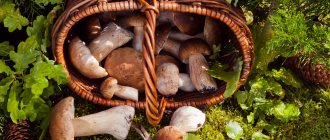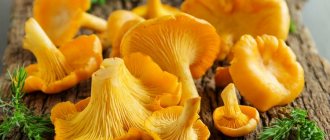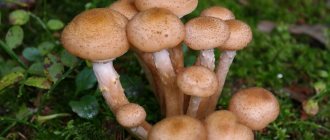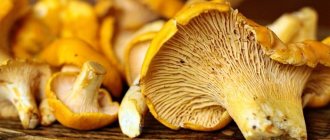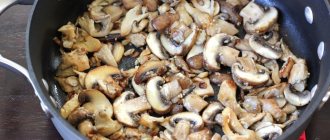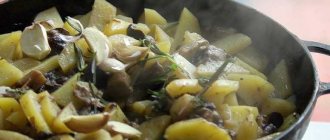4.2
(37)
- home
- /
- Garlic
- /
- When and how to harvest garlic...
I read the TOP 10 articles on Yandex and Google, and also watched the first ten videos on how to understand when it’s time to dig up garlic. According to my observations, these recommendations are not always correct. There is also downright harmful advice.
In this article you will read about the exact signs of ripening of winter, summer and “elephant” garlic. You will also find out what advice you should not trust.
Spring and winter garlic. What is the difference
Garlic is divided into winter (winter) and spring (summer) garlic. These names reflect the time of planting of the vegetable.
Winter garlic
Winter ones are planted in the fall (before winter). It takes root before frost and waits in the soil for spring. It comes up when the ground thaws. Ripens in mid-summer.
Spring garlic
Summer ones are planted in early spring. It ripens in late summer - early autumn.
Climatic characteristics of the Ural region
When growing winter and spring types of garlic in the Urals, climatic conditions should be taken into account. The specific climate of the Ural region is related to its geographical location. The area is far from the oceans and located in the interior of the continent. The flat terrain is characterized by a continental type climate.
The western part of the Urals receives a large amount of precipitation, so there is moderate humidity here. In the eastern part there is significantly less precipitation and a dry continental climate prevails in the area.
What signs of ripening winter garlic are recommended in top articles and videos
In order to get a high yield of garlic, it is important not to rush to dig it up. It is necessary to give plants the opportunity to use all the time allotted by nature to maximize the growth of their heads.
If you are late in harvesting, the crop will not be stored well.
Recommendations in top articles and videos are not diverse. Here's what the authors advise:
- Harvest 100 days after germination
- Dig on the Feast of Peter and Paul (July 12)
- Focus on an experienced neighbor and do as he does
- Look by inflorescence. When the arrow straightens and the shell on the bulbs bursts, the vegetable is ripe
- Monitor when the head skin turns purple
- Pay attention to the condition of the roots
- Watch for leaves to dry out
- Dig when the plants go down.
Let's look at these tips carefully.
The feasibility of using the lunar calendar
Some gardeners prefer to rely on the lunar calendar to decide when to dig up garlic. Harvesting on certain days is believed to extend its shelf life. Usually garlic is harvested only on the waning moon. At the same time, digging up vegetables during the full moon and new moon is strictly prohibited.
This method has its drawbacks. Weather conditions and planting dates do not always coincide with the lunar calendar. A few days of delay, and no waning moon can save overripe garlic. Therefore, you can use the lunar calendar only as a help, and not as a main guide, if it is important for you not to lose most of the harvest.
Recommendations that do not allow you to accurately determine the timing of garlic harvesting
Some signs have been known to gardeners since time immemorial. But they only allow you to roughly determine the correct time to harvest garlic.
Hundred Day Rule
According to this advice, harvesting is carried out exactly 100 days after the vegetable sprouts.
But different varieties have different ripening times. The early ones ripen after 90 days, and the late ones after 120.
The growth time is affected by the conditions of the year. In dry and hot summers it will ripen earlier. In rainy weather, the crop will grow longer.
The landing site can also make significant changes. If the bed is illuminated by the sun all day, it will ripen earlier. If the plant is in the shade for part of the day, the harvesting date is postponed.
And within the same variety, the harvest time for different plants differs. Small specimens are ready for harvesting earlier than large ones. Even when planted with cloves of the same size, the harvest will contain small and large bulbs. They will ripen at different times.
As a result, the ripening period of your crop may take 20 days, or even more.
Cleaning up for the Feast of Peter and Paul
Tying cleaning to one specific number is incorrect. In different regions, crops ripen at different times. And besides, other factors influence the ripening time.
Focus on an experienced neighbor. Clean when he cleans
This advice is not always correct. Your neighbor may have different varieties, planting dates, fertilizers, and growing techniques. A simple example. You mulched (covered with tree leaves or other organic matter) your garlic bed after planting in the fall. And they left the vegetable to grow under an organic “blanket”. But your neighbor didn’t cover the garden bed with anything. Then the neighbor’s land will warm up 7-10 days faster. And he will dig up the harvest earlier.
Cleaning times in different regions
The top articles describe in detail when to harvest garlic in different regions: in the Moscow, Leningrad, Nizhny Novgorod regions, in the Urals, in Siberia and even in Belarus. But these dates can only be a rough guide. They should not be used as a guide to action. The conditions of a particular year, the location of the bed and the techniques used by the gardener greatly change the ripening period.
The plants themselves will tell you the exact timing of ripening. And it doesn’t matter where you live - the culture signals its readiness for harvesting the same way everywhere.
Follow the arrows
The authors recommend leaving several arrows (peduncles) on the site, or one in each bed. As soon as they straighten and the shell on the inflorescences bursts, it’s time to dig up the crop.
Garlic inflorescence. The shell burst.
The question immediately arises: which arrows should be left as beacons? In different varieties they appear at different times.
And even if all the garlic is of the same variety, flower stalks do not appear at the same time. Every year I see that they, even in the descendants of the same plant, appear within 2-3 weeks. Accordingly, the arrows straighten and the shells on the inflorescences crack with a difference of 2-3 weeks.
If you left the very first arrows unbroken, then they will signal you in mid-July. The last ones were not cut off - at the end of July-beginning of August. The accuracy of such “signals” is out of the question - the range is 14-20 days .
Some arrows do not straighten completely at all. Even when the plant completely dries out and falls apart, the flower stalks remain bent.
The vegetable is ready for harvesting, but the arrow is not straightened
Not all inflorescences have a shell that bursts even when the garlic is ripe.
The garlic has already been removed from the garden, but the inflorescence has not burst.
If you leave two or three signal arrows, you may not even wait for the desired signal - straightening of the peduncle or when the inflorescence shell bursts.
Often you see a different picture. The arrows straightened, the shells on the inflorescences burst. But the plant grows quietly for another 2-3 weeks. At the same time, both the inflorescence and the head increase.
Dig up a few plants to determine if they are ready for harvest.
This technique allows you to determine the readiness of a crop for harvesting based on two criteria:
- the peel has acquired a characteristic color for the variety - usually shades of purple
- the roots begin to die.
It is worth considering that some varieties have white peel. Then you will not be able to determine whether the vegetable is ripe by the color of the onion.
The roots of ripened garlic change color from bright white to light gray. Some of the roots begin to die, they look wilted and even dried out. This means that the plant has finished growing and is going to rest.
The condition of the roots accurately indicates whether the plants are ready for harvesting.
The problem is that we only accurately determined the readiness for harvesting of the excavated specimens. We cannot look at the condition of the roots of all the other plants in the garden - they are in the soil. The garlic that was not dug up can be either underripe or overripe.
All the signs that I wrote about above can be used to determine the ripeness of the crop if you have a large garlic plantation. In this case, some of the plants will be either unripe or overripe.
For larger batches this doesn't really matter.
Collection rules
When harvesting, certain rules are followed.
- They start digging garlic only if the ground is dry. To do this, watering is stopped a week before digging.
- Use a pitchfork to dig up the garlic. They will not damage the fruits and will help loosen the soil to make it easier to pull the heads out of the ground.
- When using a shovel, dig under and then pull out the head with your hands.
- The collected heads are placed on a dry surface, the damaged garlic is set aside separately.
It is recommended to choose the morning hours for collection so that the crop can dry outside before dusk. In the evening, the harvest is brought under the roof, even if it is not cut or cleared of soil. Night humidity can spoil the harvest and make the cloves watery.
Accurate signs of ripe garlic for digging
If there are only a couple of beds of garlic, it is better to dig selectively and not all at once. We remove those plants that are ripe. And we leave those that are not ripe in the garden. This technique allows you to dig up all the plants at optimal ripeness.
I can easily cope with such crop harvesting on 3 acres. Applying selective cleaning to 1-2 beds is not a problem at all.
The leaves have dried out - a sure sign
Every article points to this sign. But how to apply it is completely unclear.
Someone talks about the beginning of yellowing of feathers (as onion leaves are often called). Others are about the beginning of drying. “Beginning” is 1-2 millimeters of the sheet or 3-4 centimeters?
Some recommend removing half the leaves when dry, others recommend removing almost all of them. And between these periods two weeks may pass. When exactly to harvest?
I dig up the garlic when the three lower feathers have dried out.
It should be borne in mind that the first sheet dries in June. By the time of cleaning, it may already fall off.
The bottom three leaves have dried up.
Why is this so?
For good storage, two conditions must coincide:
- vegetable has finished growing
- There are many scales preserved on the bulb.
The shells of the head have collapsed - the garlic will not be stored.
You can tell that a specimen has completed growth by looking at its roots.
But you don’t have to dig it up; you can see it in the feathers. Root death begins when the third leaf from the bottom has dried out. It did not turn yellow, but rather dried out.
If you dig up a plant with a yellowed but not yet dry third leaf, you will see that all the roots are still white and strong. This garlic could still grow.
The roots are all white - the garlic can still grow
When the leaf dries, grayish, yellowish and even dried roots appear. The root system began to die. It's time to dig.
The roots began to dry out - the garlic had completed its growth.
An important nuance . You can judge the state of the root system by the drying out of the third lower leaf if the arrow is removed as soon as it leaves the false stem. If the peduncle is left or removed late, the roots die later.
But you shouldn’t leave such plants in the garden - many bulb shells may collapse.
To understand how many covering scales have collapsed, you don’t need to dig it up either. This can be seen in the leaves if you understand how garlic plants are structured.
Garlic cloves grow inside a false stalk. It is formed from leaves that grow from the bottom. The glans shells are the lower parts of the feathers.
Garlic in section
While the leaf is alive, soil microorganisms do not destroy it, the peel remains intact. The feather has dried up - soil inhabitants begin to destroy the part of it that is in the ground.
In the photo: microorganisms destroyed the part of the leaf that was in the soil. The living parts of the leaves became visible - purple
The yellowed feather is still alive. Nutrients flow from it into the head. When this process is completed, the leaf dies and dries up.
If you see one bottom dried leaf, it means one shell of the head has already begun to collapse. Two dried feathers - minus two covering scales. The fewer wrappers, the worse the onion will be stored.
In the photo: 4 leaves have dried up - 4 shells are lost
If the soil is dry while the vegetable is ripening, the dead shells remain intact. With a lack of moisture, the activity of microorganisms is slowed down. But these scales have already lost their strength. Once the garlic dries, these shells will fall off when touched lightly. They are no longer of any use.
The neck of the plant becomes soft, the plants lie down
When garlic finishes growing, the roots stop working at full capacity. Less water is supplied to the tops and the plant loses turgor (it becomes not as strong as before). This is easy to understand if you feel the false stem near the ground (neck of the bulb). It becomes soft - as if empty.
In the photo: the neck of the bulb
How soft? To understand this, you need to adapt.
Feel the base of the false stem. Remember this feeling. Dig up this garlic and look at the roots. If they did not begin to die, then the neck was not soft enough.
Find a plant that has a false stem that feels softer (emptier) and also look at the roots. Through experimentation, you will learn to accurately determine by touch whether a vegetable is ready for harvesting.
And there is one “but” here . The method only works if you cut off the arrow as soon as it came out of the false stem. Then the peduncle will dry out and you will not be able to feel it inside the neck.
The arrow was removed in time - it dried up
If the arrow is cut off late, it does not dry out, but remains strong. You feel that there is a strong core inside the false stem. In this case, the neck of the onion does not become soft and the tops do not lie down.
Garlic is easily pulled out of the soil
“Under no circumstances should you pull garlic out of the soil. It needs to be undermined." This is the right advice if you do not harvest the vegetable selectively, but all at one time. Then some of the specimens turn out to be immature, and some are overripe.
In immature plants, the roots sit very firmly in the soil. If you try to pull it out without digging, you can tear off the false stem or bottom. This garlic will not be stored.
Overripe garlic roots do not hold the plant well in the soil. And the false stem has lost its strength and may break.
At proper ripeness, the bottom and false stem are still strong. And the roots already weakly hold onto the ground. Garlic is easily pulled out of the bed without a shovel, fork or other tool.
This method does not work if you have dense soil. It itself prevents the bulbs from being pulled out.
This is how I do it. I saw an onion ready for harvest. He gently pulled it up. If it doesn’t work out, I dig in.
When can you harvest garlic with arrows?
To propagate garlic, not only cloves are used, but also aerial bulbs - bulbs. They are also called "air".
Garlic fluff
In order to use the bulbs as planting material on the best plants, the flower stalks are not broken off.
Garlic plants with arrowheads approach the end of growth differently than plants whose flower stalks were removed in time. They need more time to mature. On average, they ripen 2 weeks later.
There are nuances here. We need to decide what is more important for us in such a plant - the head or the air.
If it is important that the head of garlic is well stored, we remove the specimen, guided by the drying of the three lower leaves.
If you need to get the largest possible air, we do it differently. We are waiting for the peduncle to begin to change color from bright green to dirty green with yellow tints.
A plant with flower stalks “thinks” not only about creating cloves, but also about growing flowers. Therefore, when the head is fully ripe, the roots of such a plant continue to work. And instead of leaves, a peduncle works. The formation of organic substances for the growth of bulblets (photosynthesis) occurs in it.
In this case, by the time of harvesting the head will fall apart into separate teeth. If we leave only a few inflorescences, then it’s not a big deal. The teeth can be used for food, first of all.
When to dig up garlic cloves
Single cloves are underground bulbs that are not divided into individual cloves. Such heads grow out of air.
Garlic cloves
The harvesting time depends on the time of planting the bulbs. If they were planted in the fall, the plants ripen in late June or early July. For spring planting - in September.
For the one-toothed fish, it is not so important to harvest each specimen at the optimal degree of maturity. This is planting material - it will not need to be stored in winter. Therefore, selective cleaning of single-toothed grass is not necessary. We harvest the entire crop at once.
A sign of readiness for harvesting is the lodging of all plants.
When to dig up summer garlic
Most spring varieties of the crop do not produce shoots; their false stems are softer than those of winter ones. When harvest time approaches, the plants bend over or lie down.
Lodging of garlic
In this state, the culture can still grow and enlarge the head. The exact time of readiness of each garlic is determined by the condition of the neck of the onion. Remove when it becomes soft.
If summer garlic has arrows, we determine it in the same way as for winter garlic.
When to dig elephant garlic (rocambole)
“Elephant garlic” on the English-speaking Internet is called hair onion. This plant of the onion family is very similar to garlic. It has the same head, false stem and similar leaves.
Elephant garlic
It differs from garlic in that it is much larger in size. Instead of bulbs on the peduncle, it has flowers - like onions. And from the bottom grow small one-toothed bulbs (they are called babies).
Rocambole kids
In Russia, such onions are called “rocambole”, or “garlic onions”.
The signs of readiness of this vegetable are the same as those of garlic - the condition of the lower leaves. For one-toothed “rocambole” - lodging of the tops.
What determines the planting time?
Planting of garlic begins at different periods of time. The timing of sowing is determined taking into account the variety of crop, the climate in a particular area and the duration of ripening of the selected variety.
From growing area
In different areas of the Urals, landing times vary depending on weather conditions. In the southern part, warm temperatures set in earlier, and frosts occur later than in the middle Urals.
From variety
The winter variety of the crop is usually planted at the end of September - early October. If the onset of frost is expected later, it is possible to sow in November. To choose the optimal sowing time, you need to check the soil temperature and take into account the planting depth. It is recommended to deepen the cloves into the ground 12-15 cm 5 weeks before frost. The soil temperature at the depth of planting material should be about 7 degrees.
In spring, spring varieties of garlic are planted. To carry out sowing work, it is enough to wait until the ground warms up above zero. As a rule, in the Ural region this happens in the second half of April. The spring variety is deepened by 2-4 cm.
How to dig up crops
The choice of tool for digging up garlic is limited to two options: a pitchfork and a shovel.
There are categorical statements: “Under no circumstances dig with a shovel, only with a pitchfork.” But, in fact, this is only a matter of convenience. There is no fundamental difference.
Both tools are not convenient for selective cleaning. It will not be possible to dig up one onion and not touch the neighboring ones.
I use a root remover. It is easy for them to dig up individual bulbs.
Root remover
You can use any other tool with a narrow working part.
How to protect crops from diseases and pests
Garlic culture is immune to temperature changes and pests, so problems of this nature arise quite rarely.
However, some diseases cannot be cured. These include black mold, neck rot, powdery mildew, and fusarium.
To protect fruits from harmful influences, it is recommended to use folk remedies (karbofos, onion flour, copper oxychloride).
The onion fly is considered one of the most dangerous pests. You can get rid of it by using effective insecticides.
How to prepare garlic for winter storage
Preparation for storage involves drying and trimming the crop.
There is also controversial advice.
Do I need to wash garlic after harvesting?
One of the top videos has a recommendation: wash the garlic right as you harvest. The dug up heads are placed in a bucket of water, washed, and only then removed to dry.
As the author explains, damage from pests is visible on washed heads. We leave the damaged heads for use first.
And although there is some logic to this, I would not recommend washing garlic this way.
You cannot be completely sure that the plants are free from pathogens and pests (nematodes). If a vegetable is dirty, you will only see it when you wash it. Healthy specimens can become infected from sick ones.
If the dug up bulbs and roots are very dirty, then it is better to wash them differently. Place on nets, wire boxes or straw and water with a hose. This way there is less risk of infection of healthy plants.
It’s better not to wash it, but to let the culture dry thoroughly. Then the upper scales fall off with a light touch. The heads remain clean. You will clearly see the condition of the bulbs.
How to dry garlic for storage
The authors of articles on this topic do not have a common opinion. Some advise drying in the sun, others - under a canopy.
How to do it right?
It depends on how hot and sunny it is during the harvesting period. In my practice, I noticed that a crop left in the sun during the day can get burned. The pulp of the cloves becomes transparent with a yellowish tint. The vegetable is hopelessly spoiled.
The one-toothed fish was “cooked” in the sun.
This only happens if the day is hot and clear. If the day is cloudy, there is no risk of burns.
But even in a hot region on a sunny day, it’s not scary if the dug crop lies in the sun for a couple of hours in the morning or evening. At this time the sun is not so hot.
The soil on the roots dries out and is easy to remove. Then you need to finish drying it under a canopy, in an attic or other well-ventilated place.
When can you trim garlic after harvesting?
There is no need to rush with this technique. A sign of readiness for pruning is the complete drying of all leaves and arrows. When all the shells and peduncle are dry, no infection will get into the heads.
Landing
Let's take into account all the points related to planting garlic.
Site preparation
To plant garlic, choose an area with good light throughout the day. It is also important that water does not stagnate on it. It is recommended to choose a location on a slight hill, away from large objects that may cast a shadow.
Choosing a location taking into account crop rotation
It is recommended to choose grain crops as predecessors for garlic, with the exception of oats and barley. Undesirable predecessors are onions and carrots. It is also not allowed to plant garlic in a row in the same place, since the soil will be depleted and new plants will not receive enough nutritional components.
Preparation of planting material
The cloves for sowing need to be visually inspected in order to weed out damaged and rotten specimens. If there are no defects on the cloves, the largest ones are selected. Immediately before planting, planting material is disinfected by soaking in a weakly concentrated solution of potassium permanganate for half an hour.
Setting the stage
The space allocated for the beds must be carefully dug up, leveled with a rake and compacted. During the preparation of the land, it is saturated with nutritional components. Clay soil is mixed with peat at the rate of one bucket for each square.
Loamy soil is treated with humus, rotted compost, potassium sulfate, superphosphate and lime. Sandstones are fertilized with clay and peat.
Then the surface of the bed is spilled with copper sulfate. Before sowing, the beds are covered with agrofibre or plastic film.
Forming beds
The optimal width of beds for growing garlic is 100-110 cm. Along the edges of the beds, you can build sides from boards. The height of the beds is 10-15 cm.
Technology for planting garlic crops
Sowing the crop consists of deepening the selected cloves into the prepared area. Most often, gardeners prefer to plant garlic to a depth of about 5 cm. In areas with cold climates, a depth of 15 cm is allowed so that the cloves can better withstand frost.
Harmful and senseless advice about harvesting garlic
While studying the top articles and videos, I discovered many “blunders” by the authors. Below I will give some such incorrect advice and explain why you should not follow them.
Favorable days for harvesting garlic according to the lunar calendar.
On one of the sites we read:
Ripe vegetables need to be dug up. If you wait for the correct day according to the lunar calendar, it will become overripe and will not be stored well.
The same website lists favorable days for harvesting winter and summer garlic in 2022:
For example, in the south of western Siberia, garlic is harvested in mid-July. Favorable days according to the lunar calendar are July 6, 7 and 25. It is too early to dig up the crop in the first period. In the second, it may be too late.
It is more important to harvest garlic when it is ripe, and not when the lunar calendar advises.
On which moon should you dig up garlic and why are some days favorable and others not? They write about this on another site.
In a developing plant there are no periods when the juices flow in one direction. Liquids always move both downward and upward at the same time. One vessel carries water and minerals from the roots to the tops of the plants. According to others, water and organic matter sink to the roots. You can read about this in textbooks on plant physiology.
When the garlic is ripe, the roots stop pumping water from the soil. Liquids move to storage organs - teeth and bulbs. Nutrients flow from the leaves and roots into the underground bulb and inflorescence. This happens all the time until the leaves and roots dry out. And not only on the days of the waning moon.
Is it possible to dig up garlic after rain?
If the garlic is fully ripe, then it urgently needs to be dug up.
Removing crops from wet soil is not convenient. But even worse is waiting for the ground to dry out. In wet soil, microorganisms will quickly destroy the bulb shells. The heads will fall apart into individual cloves.
Determine the ripeness of garlic by taste
The advice is meaningless. The taste of garlic at the time when it is a little under-ripe, at optimal ripeness and at a time when it is slightly over-ripe is the same.
You can taste very unripe garlic. It has not yet gained any spiciness - it has a mild taste. But at this time, tasting is not necessary - from the appearance of the garlic it is clear that it is not yet ready for harvesting. The scales on its teeth are thick and juicy. The teeth themselves are not fully formed.
If the cloves come off easily, the garlic is ripe.
At optimal ripeness, the vegetable is not so easy to separate into cloves. The onion wrappers are strong and there are many of them. The teeth in the head fit tightly.
The cloves of overripe garlic come off easily. There are few whole wrappers left on the onion. The teeth began to move away from each other. In this case, you are already late for cleaning.
The scales rustle and the flesh crunches
In the 30 years that I have been growing the crop, I have not seen rustling scales when harvesting garlic. Even if the ground is completely dry during harvesting, the shell of the head is slightly damp. And only when the vegetable dries well can you hear a characteristic sound.
The second sign is even more useless. Any housewife knows that garlic does not crunch only if it has dried out due to improper or long storage. Freshly dug garlic is crunchy in any case. Either unripe or overripe.
Loosening before harvesting
Two articles from the first page of Yandex recommend loosening the garden bed 2 days before harvesting the garlic.
I don't see any point in this advice. If the soil is dry, loosening will not change anything. If it's too wet, it will do harm. This technique is called “dry watering”. It allows you to retain moisture. But during cleaning we don’t need excess moisture.
Do I need to pick off the leaves of garlic?
Bad advice. When garlic is ripe, nutrients flow from the leaves to the head. Due to this process, teeth accumulate more nutrients and nutrients. Therefore, the plants are dried together with the tops, and only then trimmed.
How to trim garlic roots correctly
On one of the sites, the author explains in detail how to trim the roots of garlic.
This recommendation makes no sense. The crop will be stored the same regardless of root length . When preparing for storage, they die, dry out and subsequently do not affect the head in any way.
For bulbs intended for planting, the advice is even more useless. In a couple of months these heads will need to be taken apart. The roots, along with the bottom, will go to waste, and certainly will not affect the future harvest.
How was it stored in the old days?
Let's take a closer look at how to store garlic, based on the experience of our ancestors:
- Boiled vegetable oil was used for storage. The cloves were carefully torn off or the heads were placed entirely in some container. They put it in a dark place. The oil acquired a pleasant spicy taste and garlic aroma; it was used to season salads.
- The well-dried heads were sprinkled with flour. To do this, they took a box, laid out the heads of garlic in rows, sprinkled each with flour, and covered the top with a lid. The flour absorbed excess moisture well, and the garlic did not spoil until spring.
- Sprinkling with ash preserved the garlic bulbs even longer. It could be at room temperature.
- Table salt is also considered an excellent remedy: it perfectly disinfects and absorbs excess moisture.
- Our grandmothers used canvas bags for storage. First, a concentrated solution of table salt was diluted, the bags were dipped into it, then they were dried, and the garlic was placed in them. It was well protected from excess moisture and did not rot.
Some people liked to decorate the kitchen with garlic braids. To do this, its dried leaves were woven into twine, or if there was no time for weaving, the garlic was placed in nylon stockings and hung. But such a crop had to be sorted often, since there was high humidity in the kitchen. You can put the spice in boxes or baskets, then there will be free access to air. You can use onion peels for storage, sprinkle them on the bulbs, but it is recommended to protect the garlic by lifting it higher.
Well preserved in dry sawdust. It is placed in a box or box, each layer is sprinkled with sawdust.
When to clean?
When all signs indicate readiness for harvest, do not hesitate, waiting for another moment. Heads overexposed in the ground, regardless of the variety, lose their ability to be stored for long periods of time and become unsuitable for further planting.
Winter varieties typically ripen and are ready for harvest between July 25 and August 5. Spring - from the 20th of August to September 5-10. It is important to remember that harvesting may be delayed for some time due to fairly cold weather during its growing season.
Common mistakes
Let's look at common mistakes associated with garlic harvesting:
- Untimely harvesting of varieties planted before winter from the garden. An unripe vegetable loses its valuable properties, becomes soft and cannot be stored for a long time. The overripe one cracks, takes root and begins to grow in the ground again.
- The plant is not dug up carefully. The cloves become damaged, begin to rot, and part of the harvest has to be thrown away.
- Garlic heads are dried without leaves and roots. During drying for about two weeks, nutrients are transferred from the leaves and stem to the head itself. If you remove the greens, little value will remain in the product ready for storage.
- The husks are completely cleaned. It turns out that the garlic was peeled and left to survive in unfavorable conditions. The cloves will soften and dry out.
- The heads are washed and placed in plastic bags. When washing, microorganisms responsible for the health of the vegetable are removed. And the package lacks the necessary humidity and air flow. Garlic spoils quickly.
Preparing soil in the Urals for cultivation
To increase productivity and strengthen the plant, the soil must first be fertilized with chemicals containing potassium and magnesium. Among the traditional methods of fertilization, you can use humus, calculating half a bucket of fertilizing per tablespoon of ammonium nitrate, superphosphate, potassium chloride per sq. m.
Growing garlic will be unsuccessful if the soil is acidified; in such cases, the soil must be limed. After this treatment, the vegetable will grow large and will be stored longer than usual (more than one winter for sure).
Plant care in spring
Comprehensive care is the key to trouble-free cultivation of crops and a good harvest. During the garlic growing season, it is enough to adhere to basic agricultural techniques.
Watering
Garlic is considered a moisture-loving crop, and the soil must be moistened every 4-6 days. In conditions of frequent precipitation, the frequency of watering can be reduced. Before moistening the beds, you should check the degree of drying.
Weeding and loosening
You can loosen the soil after each watering to aerate and allow moisture to pass to the roots. Weeding should be done constantly as soon as the weeds begin to sprout.
Top dressing
The active development of the crop is facilitated by the application of fertilizers. It is recommended to fertilize garlic with mineral and organic substances. For convenience, you can use a complex fertilizer that contains the necessary nutritional components.
Signs of head maturation
You can determine the ripening of garlic by visual signs. Harvesting begins when the bulk of the leaves have turned yellow and began to dry, and the false stem has become soft. To check, it is recommended to dig up several heads in different parts of the beds and inspect their condition.
